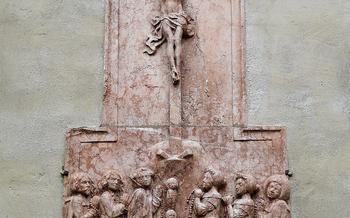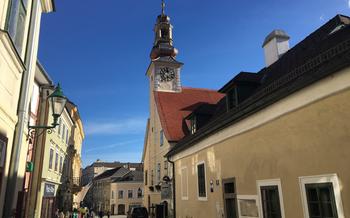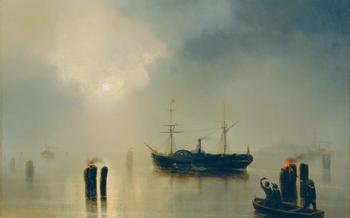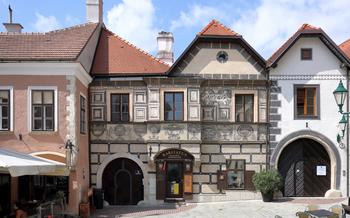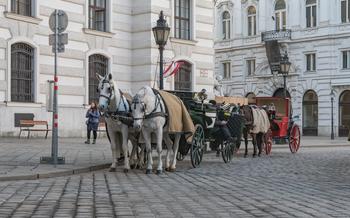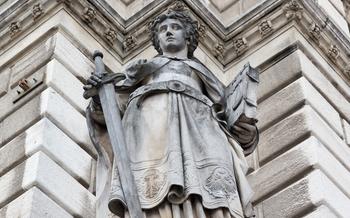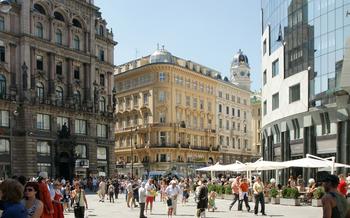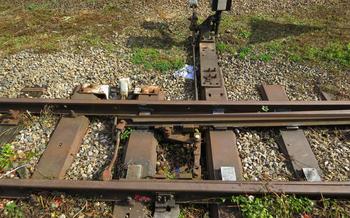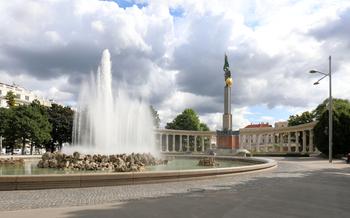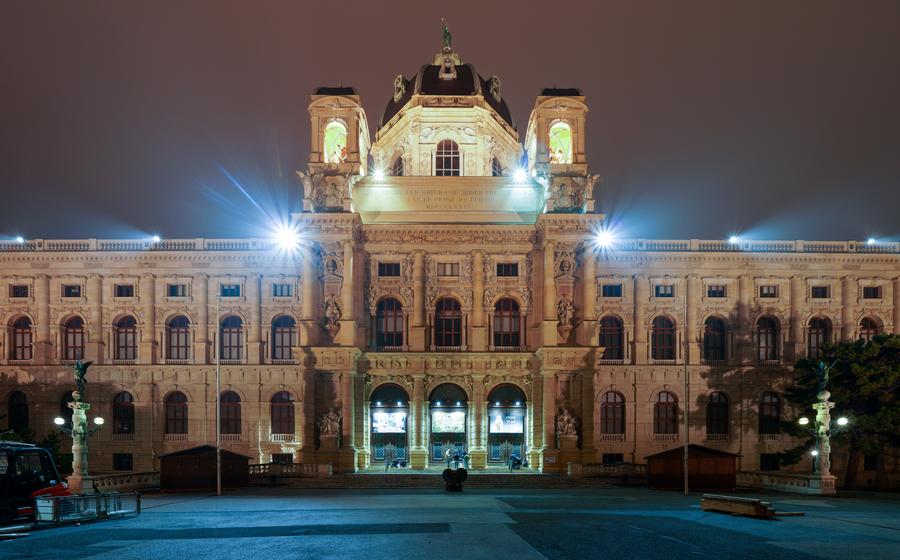
Kunsthistorisches Museum
- The Kunsthistorisches Museum: A Masterpiece of Art and History
- Egyptian and Near Eastern Collection: Unraveling Ancient Civilizations
- Greek and Roman Collection: Admiring Classical Masterpieces
- Paintings Gallery: A Treasure Trove of Artistic Genius
- Sculpture Collection: Marveling at Three-Dimensional Masterpieces
- Coin Cabinet: Exploring Monetary History and Art
- Imperial Treasury: Unveiling the Habsburg Dynasty's Splendor
- Special Exhibitions: A Window to Contemporary Art
- Guided Tours: Unveiling the Museum's Secrets
- Educational Programs: Engaging with Art and History
- Accessibility: Ensuring Inclusivity
- Museum Shop: Souvenirs and Treasures
- Insider Tip: Hidden Gems
The Kunsthistorisches Museum: A Masterpiece of Art and History
Nestled in the heart of Vienna's bustling cultural district, the Kunsthistorisches Museum stands as a testament to the city's rich artistic heritage. Founded in 1891 by Emperor Franz Joseph I, this grand institution houses one of the world's most comprehensive collections of art and artifacts, spanning from ancient civilizations to the Renaissance and beyond.
The museum's origins can be traced back to the Habsburg dynasty's vast collection of artworks, which were initially displayed in the imperial palace. As the collection grew, the need for a dedicated space to showcase these treasures became apparent, leading to the construction of the Kunsthistorisches Museum.
Designed by Gottfried Semper and Karl Freiherr von Hasenauer, the museum's building is a masterpiece in itself. Inspired by the Italian Renaissance, its grand facade features intricate carvings, sculptures, and a majestic dome that dominates the Vienna skyline. The interior is equally impressive, with opulent halls, marble staircases, and ornate ceilings that create an awe-inspiring atmosphere for visitors.
The Kunsthistorisches Museum holds a significant place in Vienna's cultural landscape. It is not only a repository of artistic treasures but also a center for research, education, and public engagement. Through its extensive collections, special exhibitions, and educational programs, the museum plays a vital role in promoting art appreciation, fostering creativity, and preserving cultural heritage for generations to come.
Egyptian and Near Eastern Collection: Unraveling Ancient Civilizations
Descend into the depths of the Kunsthistorisches Museum's Egyptian and Near Eastern Collection, a captivating realm where the secrets of ancient civilizations unfold. Journey through time as you encounter awe-inspiring artifacts from the lands of the pharaohs, the fertile crescent, and beyond.
Marvel at the intricately carved statues of Egyptian gods and goddesses, their enigmatic expressions hinting at their divine powers. Gaze upon the exquisitely painted sarcophagi, adorned with scenes from the afterlife, providing glimpses into the ancient Egyptian belief in eternal life.
Uncover the mysteries of the hieroglyphs, the ancient script that allowed the Egyptians to communicate with their gods and record their history. Explore the treasures from the tomb of Tutankhamun, including his iconic golden mask, a testament to the opulence and power of the boy king.
Delve into the world of Mesopotamia, where the civilizations of Sumer, Akkad, and Babylonia flourished. Admire the majestic winged bulls that once guarded the gates of ancient cities, their colossal size symbolizing the strength and authority of these ancient empires.
Discover the rich artistic traditions of the Near East, encompassing regions such as Syria, Palestine, and Anatolia. Witness the exquisite craftsmanship of jewelry and metalwork, adorned with intricate designs and precious gemstones. Unearth the secrets of ancient writing systems, such as cuneiform, which allowed these civilizations to record their laws, stories, and religious beliefs.
Through these remarkable artifacts, the Egyptian and Near Eastern Collection offers a profound insight into the lives, beliefs, and artistic achievements of some of the world's earliest and most influential civilizations.
Greek and Roman Collection: Admiring Classical Masterpieces
The Kunsthistorisches Museum houses an impressive collection of Greek and Roman antiquities, offering a glimpse into the artistic achievements of these ancient civilizations. Among the highlights of the collection are iconic sculptures such as the "Venus of Ephesus," a majestic marble statue depicting the goddess Aphrodite, and the "Sleeping Hermaphroditus," a beautifully rendered figure combining male and female characteristics.
Visitors can also admire a remarkable array of Greek vases, ranging from delicate black-figure pottery to intricately painted red-figure vases. These vessels, often used for everyday purposes, showcase the storytelling prowess of ancient Greek artists, depicting scenes from mythology, daily life, and religious rituals.
The Roman collection features an impressive array of busts, statues, and reliefs. Notable pieces include the "Augustus of Primaporta," a larger-than-life-size marble sculpture of the first Roman emperor, and the "Ara Pacis Augustae," a monumental altar dedicated to the goddess Pax and celebrating the peace established by Augustus.
The Greek and Roman collection at the Kunsthistorisches Museum provides a comprehensive overview of the artistic production of these ancient civilizations. Through these masterpieces, visitors can trace the evolution of artistic styles, explore mythological narratives, and gain insights into the cultural and historical significance of these ancient cultures.
Paintings Gallery: A Treasure Trove of Artistic Genius
The Paintings Gallery at the Kunsthistorisches Museum is a true testament to the artistic prowess of the Renaissance, Baroque, and Rococo periods. With masterpieces from renowned artists such as Titian, Raphael, and Rubens, this collection offers a glimpse into the evolution of painting techniques and styles that shaped Western art history.
One of the highlights of the gallery is Titian's "Venus of Urbino," a captivating portrayal of the Roman goddess of love and beauty. The painting's sensual depiction and exquisite use of color have made it an iconic work of the Renaissance.
Another must-see is Raphael's "Madonna of the Meadow," which showcases the artist's mastery of composition and his ability to capture the tender bond between mother and child. The painting's serene atmosphere and idyllic landscape have made it a beloved work of art for centuries.
Rubens' "The Raising of the Cross" is a powerful and dynamic depiction of the crucifixion of Jesus Christ. The painting's dramatic lighting, vibrant colors, and intricate details showcase Rubens' Baroque style and his ability to convey emotion and movement on canvas.
These are just a few of the many masterpieces that await visitors to the Paintings Gallery at the Kunsthistorisches Museum. Whether you are an art enthusiast or simply appreciate the beauty of great works, this collection is sure to leave a lasting impression.
Sculpture Collection: Marveling at Three-Dimensional Masterpieces
The Kunsthistorisches Museum boasts an impressive collection of sculptures spanning various periods and styles. From the intricate details of Gothic masterpieces to the expressive forms of Baroque creations, the museum offers a comprehensive journey through the history of three-dimensional art.
Notable highlights include the poignant Pietà by Michelangelo, a moving depiction of the Virgin Mary cradling the body of Christ. The museum also houses a significant collection of works by Italian Renaissance masters, including Donatello and Bernini, showcasing their exceptional skill in capturing human emotion and movement.
In the Baroque section, visitors can admire the dynamic sculptures of Gian Lorenzo Bernini, including his iconic Apollo and Daphne, which captures the moment of transformation as the nymph Daphne turns into a laurel tree to escape the pursuing god.
The museum's sculpture collection also features exquisite works from the Middle Ages, including intricate ivory carvings, wooden altarpieces, and monumental stone sculptures. These pieces offer a glimpse into the religious and artistic traditions of medieval Europe.
The interplay between form, material, and artistic expression is a defining characteristic of the museum's sculpture collection. Visitors can trace the evolution of sculptural techniques and styles, from the classical precision of Greek and Roman marble sculptures to the expressive and emotional works of the Baroque period.
Coin Cabinet: Exploring Monetary History and Art
Nestled amidst the Kunsthistorisches Museum's diverse collections, the Coin Cabinet stands as a testament to the intricate relationship between art and monetary history. Here, visitors embark on a journey through time, delving into the fascinating world of coins, medals, and banknotes from across the globe.
The Coin Cabinet boasts one of the most extensive numismatic collections in the world. With over 600,000 coins, medals, and banknotes spanning various eras and cultures, it offers a comprehensive overview of monetary history. Visitors can trace the evolution of coinage from its ancient origins to its contemporary forms, gaining insights into the economic, political, and cultural significance of coins throughout history.
Among the highlights of the collection are rare and valuable coins from ancient Greece and Rome, medieval Europe, and the Islamic world. These exquisite artifacts showcase the artistic prowess of ancient coin makers, who transformed precious metals into intricate works of art. Visitors can marvel at the intricate designs and iconography that adorned these coins, often depicting mythological figures, rulers, or important events.
The Coin Cabinet also houses an impressive collection of medals and banknotes. These objects, often commissioned to commemorate special occasions or honor individuals, provide valuable insights into historical events and the changing face of currency. Visitors can explore commemorative medals celebrating significant achievements, such as the opening of the Suez Canal or the moon landing, and examine banknotes that have shaped the global economy.
Whether you're a seasoned numismatist or simply curious about the history of money, the Coin Cabinet at the Kunsthistorisches Museum offers a captivating exploration of the intersection of art and economics. Immerse yourself in the rich stories and symbolism embedded in these tiny treasures, and gain a deeper appreciation for the enduring impact of coinage on human civilization.
Imperial Treasury: Unveiling the Habsburg Dynasty's Splendor
Descend into the depths of the Kunsthistorisches Museum to discover the Imperial Treasury, a treasure trove that holds the glittering secrets of the Habsburg dynasty. Immerse yourself in the opulence and extravagance of the imperial court as you gaze upon an array of crowns, scepters, orbs, and ceremonial objects.
Marvel at the intricate craftsmanship and symbolism embedded in each piece, reflecting the power and prestige of the Habsburgs. The Imperial Crown of Austria, a masterpiece of gold and jewels, stands as the symbol of imperial authority. Adorned with precious stones and pearls, it represents the culmination of centuries of Habsburg rule.
The Burgundian Cross, a relic of the medieval era, captivates with its intricate enamel work and historical significance. Witness the grandeur of the Order of the Golden Fleece, a prestigious honor bestowed upon noblemen by the Habsburg emperors.
Delve into the stories behind these magnificent objects and uncover the rich history of the Habsburg dynasty. The Imperial Treasury offers a glimpse into the lives of emperors, empresses, and archdukes who once ruled over a vast empire.
Special Exhibitions: A Window to Contemporary Art
The Kunsthistorisches Museum is not just a repository of historical artifacts; it also embraces contemporary art through its special exhibitions. These temporary showcases provide a platform for modern and contemporary artists to present their innovative works and engage in a dialogue with the museum's permanent collection.
Collaborating with renowned artists and institutions from around the world, the Kunsthistorisches Museum curates exhibitions that challenge traditional notions of art, explore pressing social issues, and push the boundaries of artistic expression. These exhibitions offer visitors a glimpse into the latest trends in contemporary art and provide an opportunity to experience the dynamic interplay between the old and the new.
Previous special exhibitions have featured works by renowned artists such as Andy Warhol, Jeff Koons, Ai Weiwei, and Yayoi Kusama, among others. These exhibitions have sparked thought-provoking conversations and attracted a diverse audience, demonstrating the museum's commitment to presenting a comprehensive and inclusive view of art history.
Guided Tours: Unveiling the Museum's Secrets
Immerse yourself in the captivating stories behind the Kunsthistorisches Museum's treasures with guided tours that bring the collection to life. Led by knowledgeable and passionate guides, these tours provide an in-depth exploration of the museum's highlights, uncovering hidden meanings and intriguing anecdotes.
Choose from a variety of themed tours, each focusing on a specific aspect of the collection. Delve into the grandeur of the Habsburg dynasty's imperial regalia, marvel at the intricate details of the Egyptian Book of the Dead, or admire the masterpieces of the Italian Renaissance.
With their expert insights, guides will lead you through the museum's grand halls and intimate galleries, revealing the stories behind the artworks and the artists who created them. They'll help you decipher symbolism, understand artistic techniques, and appreciate the cultural context of each piece.
Whether you're an art enthusiast, a history buff, or simply curious to learn more about the museum's treasures, guided tours offer an enriching and unforgettable experience. Book your tour in advance to secure your spot and make the most of your visit to the Kunsthistorisches Museum.
Educational Programs: Engaging with Art and History
The Kunsthistorisches Museum offers a diverse range of educational programs designed to engage visitors of all ages with art and history. These programs aim to foster art appreciation, creativity, and a deeper understanding of the museum's collections.
Workshops and Lectures:
The museum hosts regular workshops and lectures led by art historians, curators, and other experts. These sessions delve into specific themes, artistic techniques, or historical periods, providing participants with in-depth knowledge and insights.
Family Programs:
Families with children can enjoy interactive workshops and guided tours tailored to their interests. These programs introduce children to art in a fun and engaging way, encouraging them to explore their creativity and curiosity.
Art Appreciation Courses:
For those seeking a more structured learning experience, the museum offers art appreciation courses. These courses cover various topics, such as the history of art, different artistic movements, and the analysis of specific artworks.
Online Resources:
The Kunsthistorisches Museum's website provides a wealth of educational resources, including virtual tours, online exhibitions, and downloadable materials. These resources allow visitors to continue their exploration of the museum's collections from the comfort of their own homes.
Through these educational programs and resources, the Kunsthistorisches Museum strives to make art and history accessible and enjoyable for everyone, fostering a lifelong appreciation for cultural heritage.
Accessibility: Ensuring Inclusivity
The Kunsthistorisches Museum is committed to providing an inclusive and welcoming environment for all visitors, regardless of their abilities. Wheelchair accessibility is ensured throughout the museum, with elevators and ramps connecting the different floors. Visitors with disabilities can also borrow wheelchairs from the museum's information desk.
To further enhance the visitor experience, the museum offers audio guides in multiple languages, including English, German, French, Italian, Spanish, and Russian. These guides provide detailed descriptions of the museum's highlights and can be rented at the information desk.
In addition, the museum offers a range of educational programs and workshops designed to be accessible to visitors of all abilities. These programs include guided tours with sign language interpretation, tactile tours for visually impaired visitors, and sensory tours for visitors with autism or other sensory processing disorders.
By providing these services and facilities, the Kunsthistorisches Museum strives to create an environment where everyone can enjoy and appreciate the museum's rich collections and exhibitions.
Museum Shop: Souvenirs and Treasures
At the end of your visit to the Kunsthistorisches Museum, be sure to stop by the museum shop to browse a wide selection of art-related merchandise. From books and prints to replicas of museum masterpieces, you'll find unique souvenirs to remember your visit.
The shop is located on the ground floor of the museum and offers a variety of items to suit every budget. Whether you're looking for a small gift for a friend or a special piece of art for your home, you're sure to find something you'll love.
If you're looking for a truly unique souvenir, consider purchasing a replica of a museum masterpiece. The shop offers a variety of replicas, including sculptures, paintings, and jewelry. These replicas are carefully crafted to match the originals in every detail and make a wonderful way to bring a piece of the museum home with you.
The museum shop also offers a selection of books and prints related to the museum's collections. These books and prints are a great way to learn more about the history of the museum and its masterpieces.
No matter what you're looking for, you're sure to find it at the Kunsthistorisches Museum shop. So be sure to stop by and browse the selection before you leave.
Insider Tip: Hidden Gems
Beyond the renowned masterpieces, the Kunsthistorisches Museum is home to a wealth of hidden treasures waiting to be discovered. One such gem is the Egyptian Book of the Dead, an ancient papyrus scroll that provides insights into the beliefs and rituals of ancient Egyptian funerary practices. Another highlight is the Roman cameo collection, featuring intricate carvings on precious stones that showcase the artistry and craftsmanship of the Roman Empire.
To avoid the crowds and explore the museum at your own pace, consider visiting during the off-season (November to March) or on weekdays. Arrive early in the morning or late in the afternoon to enjoy a more tranquil atmosphere. Don't forget to pick up a museum map or download the audio guide app to help you navigate the vast collection and uncover its hidden secrets.
